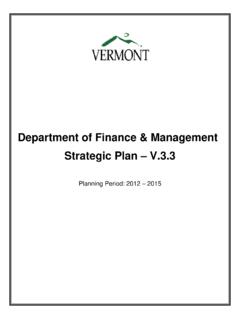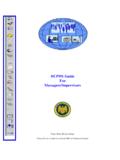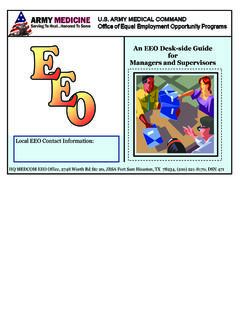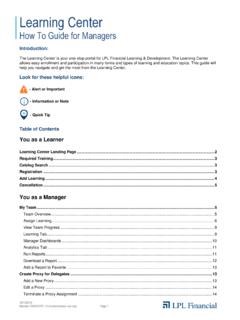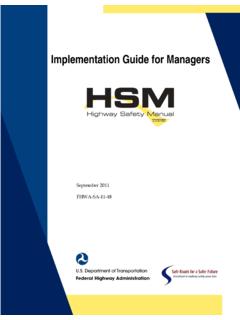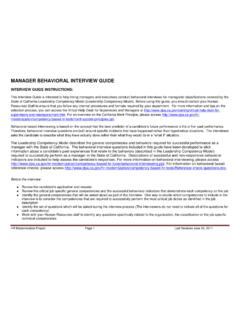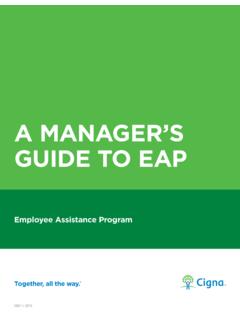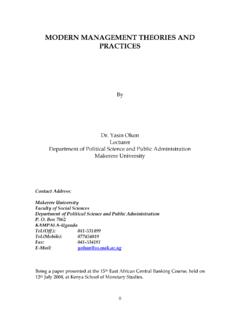Transcription of A Guide for Managers - Vermont
1 A Guide for Managers Department of Finance and Management 2 TABLE OF CONTENTS Part I: Introduction .. 3 Purpose of Guide .. 3 What Are Internal Controls? .. 3 Why Do We Need Internal Controls?.. 5 Organizational Roles .. 6 Limitations of Internal Control .. 6 Part II: Five Standards of Internal Control .. 9 Control Environment .. 9 Risk Assessment .. 10 Control Activities .. 13 Communication & Information .. 18 Monitoring .. 19 Glossary .. 21 Internal Control Reference Sources .. 24 Appendix I Evaluating Appendix II Examples of Internal Control 3 Part I: Introduction The four basic functions of management are usually described as planning, organizing, leading, and controlling. Internal control is what is meant when discussing the fourth function, controlling.
2 Adequate internal controls allow Managers to delegate responsibilities to staff and contractors with reasonable assurance that what they expect to happen, actually does. Internal control is an integral part of managing an organization. It comprises the plans, methods, and procedures used to meet missions, goals, and objectives and, in doing so, supports performance-based management systems. Internal control also serves as the first line of defense in safeguarding assets and preventing and detecting errors and fraud. In short, internal control, which is synonymous with management control, helps government Managers achieve desired results through effective stewardship of public resources.
3 Purpose of Guide Everyone experiences internal control in their daily business activities as well as in their personal lives. Yet it is a subject that is very often misunderstood, ignored or undervalued. Internal control helps bring order, direction and consistency to our lives and organizations. This publication is intended to explain how internal control plays an important part in the daily activities of every department1 in Vermont state government. Although an internal control system can vary widely among organizations, the standards for a good system are generally the same. The standards presented in this publication are applicable to all state government departments. These standards are not new ideas; many of the concepts are currently part of existing operations.
4 We have prepared this publication to assist all state employees in managerial roles in fulfilling their responsibilities relating to internal controls. We do not suggest, however, that this publication is all-inclusive. Managers should view this Guide as a framework for developing and evaluating their internal control systems, consistent with their department s operations and mission. What Are Internal Controls? Definition The current official definition of internal control was developed by the Committee of Sponsoring Organization (COSO) of the Treadway Commission. In its influential report, Internal Control - Integrated Framework, the Commission defines internal control as: 1 Department means any discrete agency, department, office, board or other administrative unit.
5 4 Internal control is a process, effected by an entity's board of directors, management and other personnel, designed to provide reasonable assurance regarding the achievement of objectives in the following categories: Effectiveness and efficiency of operations. Reliability of financial reporting. Compliance with applicable laws and regulations. A less technical definition might state that: Internal control is the integration of the activities, plans, attitudes, policies, and efforts of the people of a department working together to provide reasonable assurance that the department will achieve its mission. Fundamental Concepts These definitions denote certain fundamental concepts, that internal controls: affect every aspect of a department: all of its people, processes and infrastructure.
6 Are not stand-alone practices. They are woven into the day-to-day responsibilities of Managers and their staff. incorporate the qualities of good management. are dependent upon people and will succeed or fail depending on the attention people give to it. must make sense within each department s unique operating environment and are effective when people work together. provide a level of assurance to a department, but does not guarantee success. help a department achieve its mission. should be cost effective. 5 Why Do We Need Internal Controls? Encourage Sound Management Practices Departments exist to achieve a mission and accomplish certain goals and objectives. The overall purpose of internal control is to help each department achieve its mission.
7 An effective internal control system helps a department to: Promote orderly, economical, efficient and effective operations. Produce quality products and services consistent with the department's mission. Safeguard resources against loss due to waste, abuse, mismanagement, errors and fraud. Promote adherence to statutes, regulations, bulletins and procedures. Develop and maintain reliable financial and management data, and accurately report that data in a timely manner. Accountability Public sector Managers are responsible for managing the resources entrusted to them to carry out government programs. A major factor in fulfilling this responsibility is ensuring that adequate controls exist. Public officials, legislators, and taxpayers are entitled to know whether government agencies are properly administering funds and complying with laws and regulations.
8 They need to know whether government organizations, programs, and services are achieving the purposes for which they were authorized and intended. Officials and employees who manage programs must be accountable to the public. Frequently specified by statute, this concept of accountability is intrinsic to the governing process of our state. Facilitate Preparation for Audits Vermont state government is subject to annual audits by independent auditors ( the single audit, federal auditors, the Office of the State Auditor) and, in some cases, internal audit units. These audits are conducted to ensure the following: Public funds are administered and expended in compliance with applicable statutes and regulations. Programs are achieving the purpose for which they were authorized and intended.
9 6 Financial statements accurately represent the operating results and financial position of the State. Programs are managed economically; and Internal controls exist and provide a basis for planning the audit and planning the timing, nature, and extent of testing. Auditors' reports will nearly always include an evaluation of the adequacy of the department s internal controls. When it appears warranted, auditors will make recommendations for improvements. Management is accountable for the adequacy of the internal control systems in their department. Weak or insufficient internal controls will result in audit findings and, more importantly, could lead to theft, shortages, operational inefficiency, or a breakdown in the internal control structure.
10 Strong, effective, well-documented internal controls that have been made a part of the entity s operations allow audits to be performed more cost effectively. Organizational Roles An organization is a group of individuals working together to achieve a common purpose. Each person employed by an agency, department, office, board, or commission works for an organization that is a part of a larger organization, the State of Vermont . Every member of our state organization has a role in the system of internal control. Most importantly, internal control is people-dependent. It is developed by people; it guides people; it provides people with a means of accountability; and people carry it out. Individual roles in the system of internal control vary greatly throughout an organization.
